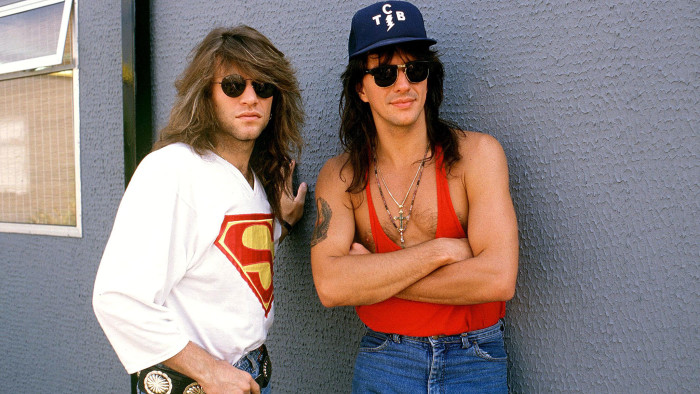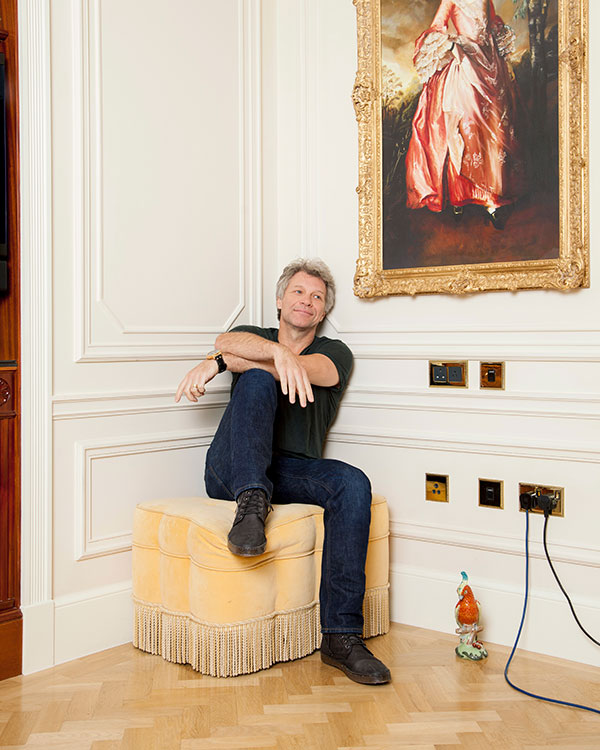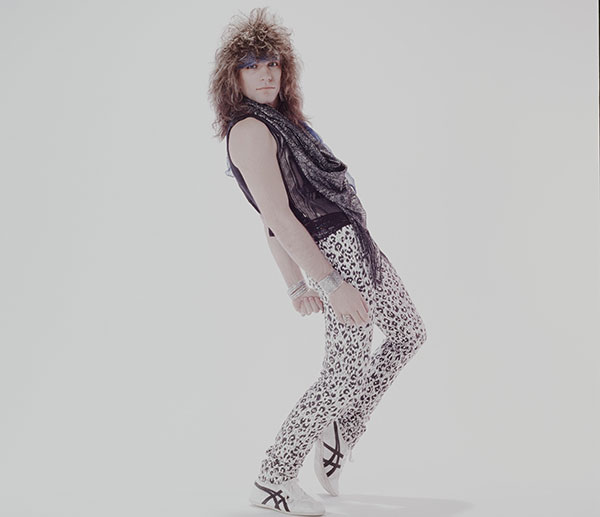Jon Bon Jovi on hard work, losing his wingman and US inequality

Simply sign up to the Life & Arts myFT Digest -- delivered directly to your inbox.
Jon Bon Jovi’s handshake is firm and to the point, not quite the full bone-cruncher but hinting at the capacity to do metacarpal damage. The shake is a decisive up and down, accompanied by steady eye contact. It is the polite but no-nonsense, let’s-do-this-thing greeting of a cowboy-film enthusiast from New Jersey who heads one of the biggest rock bands in the world.
The setting is a private reception room at The Savoy, London’s venerable luxury bolt-hole. In February, the rock singer will begin a concert tour in the US and Canada with his band, Bon Jovi, to promote their new album This House Is Not for Sale.
Released in November, it entered the US charts at number one, the sixth time one of their albums has reached the top spot, although it went on to exit the charts almost as precipitously.
As with other bands of their vintage, live performance is where the real business lies for Bon Jovi these days. Their “Because We Can” tour was the highest-grossing in the world in 2013, earning $205m according to trade magazine Billboard.
But the one starting next month marks a new chapter in the band’s 34-year life. It is their first US tour without guitarist Richie Sambora, who left in 2013. Jon Bon Jovi has lost his wingman.

“The Richie scenario,” he calls it. “I can delve deeper into that if you want,” he says, fixing me with his blue eyes.
We sit facing each other in daintily upholstered chairs, by a table with a bottle of artesian water shipped from Fiji. At 54, Bon Jovi has retained his famous good looks. Perfect teeth, strong jawline, fit physique, blue jeans, big watch, hair a buoyant ashy thatch. From time to time, in order to emphasise a point, he leans forward to tap me lightly on the knee, an endearing act of tactility. The man formerly known as John Bongiovi has Sicilian roots on his father’s side.
Bon Jovi, the band, is his creation. It was formed in 1983 with the recruitment of four fellow New Jersey musicians: Sambora, pianist David Bryan, drummer Tico Torres and ex-bassist Alec John Such, who left in 1994. Their apotheosis came with the 1986 album Slippery When Wet, a monster hit that spawned US number one singles “Livin’ on a Prayer” and “You Give Love a Bad Name”. In the finest decade for air-punching anthems in the history of music, Bon Jovi punched the air with the best of them: “Oh we’re halfway there/Oh-oh we’re livin’ on a prayer!”
The band have more than 120m record sales to their name, mostly consisting of songs co-written by Sambora and the singer. “He was my brother, my best friend,” Bon Jovi says, in a pained tone. “We were very similar. We still are very similar. We both wrote lyrics, we both wrote music, we both sing. The same. We just complemented each other.”
Sambora’s departure followed a long struggle with drink and painkiller addiction, involving spells in rehab and missed shows. In this he is unlike the punctual, clean-living Bon Jovi. The final straw came during the 2013 tour when the guitarist failed to turn up to a Canadian arena concert.

“There was no time to be mad or sad. You had to do it. And as a band we had to circle the wagons because of the resp-ons-ibil-ity” — Bon Jovi enunciates each syllable as though chiding the absent Sambora — “responsibility to each other, to the crew, to the records, to the fans. You don’t just say, ‘I don’t want to come into work today, I’m not in good shape.’ F*ck you.”
The upheaval provoked a long period of musical inactivity after the tour ended. “I couldn’t sing in the shower!” he says. “I’m not exaggerating. I couldn’t f*cking sing.”
Other factors aggravated the turmoil. A complicated dispute with their record label, Mercury Records, led the band to leave its roster, sign elsewhere and then return to a Mercury subsidiary. Meanwhile, Jon joined a consortium bidding to buy the US football team the Buffalo Bills, a tantalising opportunity to secure an NFL franchise.
It made him the most hated man in Buffalo, the team’s upstate New York hometown. Bars declared themselves “Bon Jovi-free zones”. Radio stations wouldn’t play the band’s songs.

“My business partners being Canadian, there was an assumption that I was going to move the team across the border. And this very small town has a very large inferiority complex,” he says with a chuckle.
The failure of the bid in 2014 was no laughing matter, however. “I would have invested my life savings, everything I had ever earned. It was 27 months of focused work,” he says ruefully.
Hard work is a recurring theme in Bon Jovi’s life. Born in 1962, he was raised with two brothers in Sayreville, a New Jersey factory town 30 miles south of New York City. His parents were both ex-Marines, each working six-day weeks.
Mrs Bongiovi, briefly a Playboy bunny before joining the military, had a job as a florist. Mr Bongiovi was a hairdresser. (Hair is another major theme in Bon Jovi’s life.)
He grew up inspired by the “Jersey Shore” sound, a rock scene centred on the state’s seaside resorts and roadside bars, a working-class circuit where Bruce Springsteen cut his teeth alongside bands such as Southside Johnny & The Asbury Jukes.
“Led Zeppelin, whose poster hung on my wall — they were too big to think you could ever be like them. Queen and the Stones, no way. It was unfathomable,” he remembers. “But Johnny and Bruce, 25 miles away from where I grew up — that made it real.”

He formed a band called Atlantic City Expressway at high school in 1979. His musical apprenticeship included a spell working as a janitor at a New York recording studio owned by a cousin, for $50 a week.
It led to his first professional recording, singing with a children’s choir on the song “R2-D2, We Wish You a Merry Christmas” for a Star Wars-themed festive album in 1980: an unpromising debut for the future pop-metal pin-up.
Bon Jovi, the band, came together in 1983 after he wrote his first successful song, “Runaway”. Two albums followed; then came Slippery When Wet in 1986, which went on to sell 28 million copies. “It was one of those records,” Bon Jovi says. “One in a thousand bands get to have those pinnacle albums.”
The band’s breakthrough came during the heyday of “glam metal”, a Los Angeles scene characterised by outrageous male peacockery, led by the spandex-wearing, drug-guzzling, women-chasing reprobates of Mötley Crüe.
But while Bon Jovi had the big hair — none more so than their lustrously hirsute frontman — they stood apart from their glam contemporaries, separated by geography and temperament.
“We looked much more like guys from New Jersey,” the singer says. “We were more masculine than they were. We may have been cute but we weren’t wearing girls’ make-up.”

The cuteness contributed to their success but also brought problems. Male stars often struggle to deal with the female frenzy they inspire. A recent example came when Justin Bieber halted a concert in Manchester because of his fans’ screaming. Being objectified as a pretty thing can play havoc with male self-regard, at once puffing the star up and making him feel undervalued.
Bon Jovi’s first cover story for Rolling Stone magazine, conducted by a female writer and photographer in 1987, marked a low point for the singer. “That broke my heart. All the girl cared about was, ‘Take off your jacket, one sleeve, pout for me and I’m going to take your picture,’” he says.
“And all the reporter wanted to talk about was how cute I was. They shoulda maybe sent a guy to do the interview. At the time I was really disappointed because I thought, ‘I’ve worked hard enough to get here.’”
In 1989 he married his wife, Dorothea, in a secret ceremony in Las Vegas. His management was furious, afraid it would alienate the band’s female fanbase. In 1992, when the singer sheared off his long locks, the event made news on CNN.
“Now I’m not upset by it,” he says, in reference to the focus on his appearance. “I’m still writing number one songs, so I guess I proved the point that we weren’t just that flash in the pan.”

The band’s longevity is remarkable, far in excess of former peers such as Def Leppard. Blending pop with hard rock, they were initially viewed as lightweights.
“Jon Bon Jovi is brilliant . . . at what he does,” Rolling Stone sniped in its review of Slippery When Wet’s 1988 follow-up, New Jersey. It proceeded to sell 18 million copies and spawned another tranche of classic anthems (“Bad Medicine”, “Lay Your Hands on Me”).
There have been difficult periods. “It’s all over for Bon Jovi,” a headline in a UK tabloid announced in 1990, amid reports of band tensions. Jon insisted they enter group therapy with a professional mediator. Keep the Faith followed in 1992, launching a run of platinum-selling albums that continued throughout the 1990s and the 2000s.
Meanwhile, Bon Jovi launched a side-career as an actor, appearing in films and television programmes. In a tongue-in-cheek allusion to his unwanted sex-symbol status, he appeared in a Sex and the City episode as a man in therapy who loses interest in women after sleeping with them.

He once likened his role as Bon Jovi’s leader to being a chief executive of a corporation. “I can still live with that one,” he says. “It’s not like I sit behind a desk. But in the vein of what was good about Henry Ford, he had a concept and then carried out his plan. It’s not dissimilar from his style of management — although I haven’t created my own little cult and put them all in a village.”
Images of work run through his songs, from the struggling dockworker portrayed in “Livin’ on a Prayer” to “Labor of Love” on the new album (“It’s a full-time job, the work’s never done”).
He described himself in the past as a workaholic, although insists he is not one any more. “Back in my earlier days I would have termed myself that but not for the last decade,” he says. “When you get to a certain age you realise that there’s more to life than wanting to be the lead singer of a rock band.”
He and Dorothea, who he met at high school, are still married. They live in a large mansion in Middletown, a prosperous New Jersey town, and have four children ranging in age from 12 to 23. “The older ones were accustomed to me going for long stretches of time. The two young ones are like, ‘You’ve been gone for four days, this is bullshit!’”
Like New Jersey’s other blue-collar rock superstar, Bruce Springsteen, Bon Jovi’s outlook is liberal. In 2006 he launched the Jon Bon Jovi Soul Foundation to combat hunger and homelessness.
He appeared at rallies for Hillary Clinton during the presidential election, as he has for previous Democrats.

“We don’t need Jon Bon Jovi,” Donald Trump declared in November, and events proved the president-elect right. Our meeting takes place on the eve of Trump’s surprise victory. The tycoon was a rival bidder for the Buffalo Bills football team, although like Bon Jovi he did not succeed. The singer picks his words carefully when talking about the divisions in the US.
“There’s a lot of proud people here in the UK that are dealing with a very similar situation to what’s going on in America. The have-and-have-not society. People worried, people living in fear. They deserve to be worried.
“The only thing that would have been great for the disenfranchised part of populace is if they could have a better mouthpiece to deliver their message. Then we could have had a really sane conversation between two adults about bigger government or smaller government.
“Because I could be swayed. If some great Republican leader came along and said, ‘This is why it doesn’t work, this is why there is no pot of gold,’ I think I could have sat there and got it.”
This House Is Not for Sale’s cover is a black-and-white photomontage by the US photographer Jerry Uelsmann. It shows a sturdy but derelict mansion growing out of a tangle of tree roots.
The album is slicker and less knotty than the image suggests, but it has its moments. One is the title track, a muscular anthem about not giving up. The work goes on.
“That picture spoke volumes to me — about me, about us, about where I’m at in life, about where I think life is,” Bon Jovi says. “A once-proud house with deep roots that’s a little tarnished. But it certainly isn’t going anywhere.”
Ludovic Hunter-Tilney is the FT’s pop critic
Portraits: Kalpesh Lathigra; additional photography: Getty; Redferns;
Comments